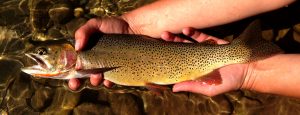Join us in protecting Jackson Hole’s water resources and native trout!
Why Trout Friendly?
Nutrient pollution from lawn care practices, such as fertilizing and overwatering, are impacting our waterways. Excess nutrients can lead to increased algae and aquatic plant growth, which can harm aquatic habitats and disrupt the ecosystem. The Trout Friendly Lawns program is designed to be easy for both residents and landscaping professionals to implement. By committing to Trout Friendly landscaping practices, we can collectively improve water quality for the health of all the plants, insects, fish, wildlife, and humans that rely on clean water. Join over 100 residents, businesses, and public parks in committing to Trout Friendly landscaping practices.
Certify your lawn as Trout Friendly:
Basic Level Certification Gold Level Certification

